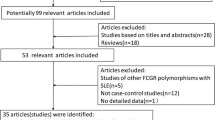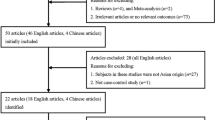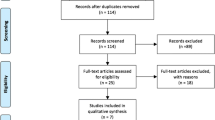Abstract
The Fas gene polymorphisms −670A/G (rs1800682) and −1377G/A (rs2234767) have been shown to be associated with systemic lupus erythematosus (SLE), but findings are not consistent. To clarify this point, a meta-analysis was performed. We searched PubMed, CNKI, CBM and Wanfang database. Meta-odds ratios (ORs) and 95 % confidence intervals (95 % CIs) were used to combine the data by fixed/random effects models based on heterogeneity test. The statistical analyses were conducted using Stata software. A total of seven studies involving 759 cases and 820 controls were considered in this study and ethnicity-specific meta-analysis was performed on Caucasian and Asian population. In overall population, meta-analysis revealed a trend toward to an association between SLE and Fas −670 A allele (OR = 1.310, 95 %CI = 1.028 ~ 1.670, P = 0.029). Similar results were detected in recessive model (OR = 1.626, 95 %CI = 1.104 ~ 2.395, P = 0.014) and in homozygous genotypic contrast (OR = 1.728, 95 %CI = 1.049 ~ 2.848, P = 0.032). Stratification by ethnicity indicated a significant association between SLE and the Fas −670A/G polymorphism in Asian population when allelic contrast (OR = 1.331, 95 %CI = 1.066 ~ 1.662, P = 0.011), homozygous genotypic contrast (OR = 1.848, 95 %CI = 1.164 ~ 2.932, P = 0.009) and dominant model were performed (OR = 1.542, 95 %CI = 1.045 ~ 2.275, P = 0.029). Meta-analysis of the Fas −1377G/A polymorphism indicated a significant association between SLE and the G allele in overall population (OR = 1.277, 95 %CI = 1.004 ~ 1.624, P = 0.046). The results from this meta-analysis provide evidence for the association between the Fas −670A/G and −1377G/A polymorphism and the risk of SLE. However, further studies are needed to draw a definitive conclusion.








Similar content being viewed by others
References
Munoz LE, van Bavel C, Franz S et al (2008) Apoptosis in the pathogenesis of systemic lupus erythematosus. Lupus 17:371–375
Liphaus BL, Kiss MH (2010) The role of apoptosis proteins and complement components in the etiopathogenesis of systemic lupus erythematosus. Clinics (Sao Paulo) 65:327–333
Li LH, Li WX, Wu O et al (2009) Fas expression on peripheral blood lymphocytes in systemic lupus erythematosus: relation to the organ damage and lymphocytes apoptosis. Mol Biol Rep 36:2047–2052
Leithäuser F, Dhein J, Mechtersheimer G et al (1993) Constitutive and induced expression of APO-1, a new member of the nerve growth factor/tumor necrosis factor receptor superfamily, in normal and neoplastic cells. Lab Invest 69:415–429
Suda T, Takahashi T, Golstein P et al (1993) Molecular cloning and expression of the Fas ligand, a novel member of the tumor necrosis factor family. Cell 75:1169–1178
Nagata S, Suda T (1995) Fas and Fas ligand: lpr and gld mutations. Immunol Today 16:39–43
Mysler E, Bini P, Drappa J et al (1994) The apoptosis-1/Fas protein in human systemic lupus erythematosus. J Clin Invest 93:1029–1034
Bijl M, Horst G, Limburg PC et al (2001) Fas expression on peripheral blood lymphocytes in systemic lupus erythematosus (SLE): relation to lymphocyte activation and disease activity. Lupus 10:866–872
Ohsako S, Hara M, Harigai M et al (1994) Expression and function of Fas antigen and Bcl-2 in human systemic lupus erythematosus lymphocytes. Clin Immunol Immunopathol 73:109–114
Green DR (2003) Overview: apoptotic signaling pathways in the immune system. Immunol Rev 193:5–9
Hao JH, Ye DQ, Zhang GQ et al (2006) Elevated levels of serum soluble Fas are associated with organ and tissue damage in systemic lupus erythematosus among Chinese. Arch Dermatol Res 297:329–332
Telegina E, Reshetnyak T, Moshnikova A et al (2009) A possible role of Fas-ligand-mediated “reverse signaling” in pathogenesis of rheumatoid arthritis and systemic lupus erythematosus. Immunol Lett 122:12–17
Inazawa J, Itoh N, Abe T, Nagata S (1992) Assignment of the human Fas antigen gene (Fas) to 10q24.1. Genomics 14:821–822
Huang QR, Morris D, Manolios N (1997) Identification and characterization of polymorphisms in the promoter region of the human Apo-1/Fas (CD95) gene. Mol Immunol 34:577–582
Huang QR, Danis V, Lassere M et al (1999) Evaluation of a new Apo-1/Fas promoter polymorphism in rheumatoid arthritis and systemic lupus erythematosus patients. Rheumatology (Oxford) 38:645–651
Huang QR, Manolios N (2000) Investigation of the −1377 polymorphism on the Apo-1/Fas promoter in systemic lupus erythematosus patients using allele-specific amplification. Pathology 32:126–130
Lee YH, Kim YR, Ji JD et al (2001) Fas promoter −670 polymorphism is associated with development of anti-RNP antibodies in systemic lupus erythematosus. J Rheumatol 28:2008–2011
Kanemitsu S, Ihara K, Saifddin A et al (2002) A functional polymorphism in fas (CD95/APO-1) gene promoter associated with systemic lupus erythematosus. J Rheumatol 29:1183–1188
Xu AP, Yin PD (2004) Association of Fas promoter −670 polymorphism with systemic lupus erythematosus in southern Chinese. Chin J Pathophysiol 20:1819–1822 (Article in Chinese)
Arasteh JM, Sarvestani EK, Aflaki E et al (2010) Fas gene polymorphisms in systemic lupus erythematosus and serum levels of some apoptosis-related molecules. Immunol Invest 39:27–38
Molin S, Weiss EH, Ruzicka T et al (2012) The FAS/cd95 promoter single-nucleotide polymorphism −670 A/G and lupus erythematosus. Clin Exp Dermatol. doi:10.1111/j.1365-2230.2011.04296.x
Egger M, Davey Smith G, Schneider M et al (1997) Bias in meta-analysis detected by a simple, graphical test. BMJ 315:629–634
DerSimonian R, Laird N (1986) Meta-analysis in clinical trials. Control Clin Trials 7:177–188
Mantel N, Haenszel W (1959) Statistical aspects of the analysis of data from retrospective studies of disease. J Natl Cancer Inst 22:719–748
Higgins JP, Thompson SG (2002) Quantifying heterogeneity in a meta-analysis. Stat Med 21:1539–1558
Begg CB, Mazumdar M (1994) Operating characteristics of a rank correlation test for publication bias. Biometrics 50:1088–1101
Zou YF, Feng XL, Pan FM et al (2010) Meta-analysis of TNF-alpha promoter: 238A/G polymorphism and SLE susceptibility. Autoimmunity 43:264–274
Liu H, Pope RM (2003) The role of apoptosis in rheumatoid arthritis. Curr Opin Pharmacol 33:317–322
Broen J, Gourh P, Rueda B et al (2009) The FAS −670A > G polymorphism influences susceptibility to systemic sclerosis phenotypes. Arthritis Rheum 60:3815–3820
Mahfoudh W, Bel Hadj Jrad B, Romdhane A et al (2007) A polymorphism in FAS gene promoter correlated with circulating soluble FAS levels. Int J Immunogenet 34:209–212
Conflict of interest
No conflict of interest had been declared by the authors.
Author information
Authors and Affiliations
Corresponding author
Rights and permissions
About this article
Cite this article
Xiang, N., Li, Xm., Wang, Gs. et al. Association of Fas gene polymorphisms with systemic lupus erythematosus: a meta-analysis. Mol Biol Rep 40, 407–415 (2013). https://doi.org/10.1007/s11033-012-2075-0
Received:
Accepted:
Published:
Issue Date:
DOI: https://doi.org/10.1007/s11033-012-2075-0




